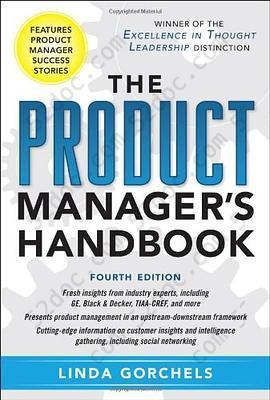注重体验与质量的电子书资源下载网站
分类于: 设计 云计算&大数据
简介

The Product Manager's Handbook 豆 0.0分
资源最后更新于 2020-07-27 14:51:24
作者:Gorchels, Linda
出版社:McGraw-Hill
出版日期:2011-01
ISBN:9780071772983
文件格式: pdf
标签: 产品经理 商业 管理 科技 成长 思维 产品管理 英文原版
简介· · · · · ·
This is the essential guide to seamless product management for today's fluid, unpredictable business world. Long considered the most useful and insightful guide of its kind, "The Product Manager's Handbook" has been fully revised and updated to give you the edge in today's challenging business landscape. It features expanded coverage of product development processes, intelligen...
目录
Section One: Bedrock Concepts
Chapter 1. The multi-faceted nature of product management jobs and structure
a. Your job is unique ' but you're not alone
b. Product management can work for services, too!
Chapter 2. Leadership and management competencies
a. Change management
b. Surviving matrix structures and cross-functional teams
c. Tips to improve decision making
Chapter 3. Business competencies
a. Basic financial concepts
b. Assembling forecasts
c. Running a 'virtual' business
Chapter 4. Market knowledge competencies: fact capturing
a. Trend-spotting, research and customer segmentation
b. Describing the customer purchase process, personas and value chain
c. Competitive intelligence briefings
d. Technology assessment and design thinking
Chapter 5. Planning frameworks
a. The product manager continuum: from upstream to downstream
b. Introduction to portfolios
c. Innovation, revitalization, protection and sunsetting
Section Two: Upstream product management: Strategic new products & initiatives
Chapter 6. Roadmaps, strategic plans and innovation directives
a. Visualizing the future: three time horizons
b. Time management of the pipeline
c. Making buy, build or partner decisions
Chapter 7. Managing the fuzzy front end of new product processes
a. Balancing breakthroughs and incremental changes
b. Defining current and future customer need-drivers
c. Generic NPD processes and stage-gates
Chapter 8. Creating ' and getting approval for ' business cases
a. Understanding the importance of the business case
b. Estimating and validating demand
c. Requirements planning, management and clarification of feasibility
d. Framing and justifying the investment
e. The provisional marketing plan
Chapter 9. Overseeing new product projects
a. Attributes and responsibilities of core teams
b. Team decisions and processes
c. Managing scope creep
d. Guiding gate reviews and readiness to move to each level
e. Improving beta programs
Chapter 10. Formulating and executing launch plans
a. The major components of the launch document & process
b. Incorporating belief builders
c. Building in early tracking measures
d. Preparing red alert strategies
e. The final analysis: project and process reviews
Section Three: Downstream product management: Marketing and ongoing support
Chapter 11. Generating brand equity
a. Cultivating brands and positioning from the outside in
b. Brand elements, structure and strategy
Chapter 12. Lifecycle management and marketing
a. Categorizing products for streamlined efforts
b. Defensive and offensive considerations
c. Revitalization programs: product versioning
d. Revitalization programs: refocused marketing schema
e. Right-pricing your products
Chapter 13. Supporting sales and channel efforts
a. Lead generation, referrals, and collateral
b. Call support, demos and presentations
c. Converting product marketing plans into sales calls
Chapter 14. Marketing communications, SEO and social networking
a. Who should write the copy and what should it say
b. From broadcast to narrowcast approaches
c. Make the message resonate with the right customers
d. Manage the sales funnel
Chapter 15. Sunsetting
a. Defining kill criteria: the "Cockroach" problem
b. Evaluating alternative approaches for product elimination
Section Four: Fine-tuning
Chapter 16. Establishing a global mindset
a. Global versus multi-local products: decision points> b. When product development is handled in another country
c. Working with cross-cultural co-workers on project teams
d. Communicating across borders and cultures
Chapter 17. Goal and performance alignment
a. Linking goals, directives and initiatives
b. Defining appropriate product manager performance measures
c. Coaching toward proficiency
Chapter 1. The multi-faceted nature of product management jobs and structure
a. Your job is unique ' but you're not alone
b. Product management can work for services, too!
Chapter 2. Leadership and management competencies
a. Change management
b. Surviving matrix structures and cross-functional teams
c. Tips to improve decision making
Chapter 3. Business competencies
a. Basic financial concepts
b. Assembling forecasts
c. Running a 'virtual' business
Chapter 4. Market knowledge competencies: fact capturing
a. Trend-spotting, research and customer segmentation
b. Describing the customer purchase process, personas and value chain
c. Competitive intelligence briefings
d. Technology assessment and design thinking
Chapter 5. Planning frameworks
a. The product manager continuum: from upstream to downstream
b. Introduction to portfolios
c. Innovation, revitalization, protection and sunsetting
Section Two: Upstream product management: Strategic new products & initiatives
Chapter 6. Roadmaps, strategic plans and innovation directives
a. Visualizing the future: three time horizons
b. Time management of the pipeline
c. Making buy, build or partner decisions
Chapter 7. Managing the fuzzy front end of new product processes
a. Balancing breakthroughs and incremental changes
b. Defining current and future customer need-drivers
c. Generic NPD processes and stage-gates
Chapter 8. Creating ' and getting approval for ' business cases
a. Understanding the importance of the business case
b. Estimating and validating demand
c. Requirements planning, management and clarification of feasibility
d. Framing and justifying the investment
e. The provisional marketing plan
Chapter 9. Overseeing new product projects
a. Attributes and responsibilities of core teams
b. Team decisions and processes
c. Managing scope creep
d. Guiding gate reviews and readiness to move to each level
e. Improving beta programs
Chapter 10. Formulating and executing launch plans
a. The major components of the launch document & process
b. Incorporating belief builders
c. Building in early tracking measures
d. Preparing red alert strategies
e. The final analysis: project and process reviews
Section Three: Downstream product management: Marketing and ongoing support
Chapter 11. Generating brand equity
a. Cultivating brands and positioning from the outside in
b. Brand elements, structure and strategy
Chapter 12. Lifecycle management and marketing
a. Categorizing products for streamlined efforts
b. Defensive and offensive considerations
c. Revitalization programs: product versioning
d. Revitalization programs: refocused marketing schema
e. Right-pricing your products
Chapter 13. Supporting sales and channel efforts
a. Lead generation, referrals, and collateral
b. Call support, demos and presentations
c. Converting product marketing plans into sales calls
Chapter 14. Marketing communications, SEO and social networking
a. Who should write the copy and what should it say
b. From broadcast to narrowcast approaches
c. Make the message resonate with the right customers
d. Manage the sales funnel
Chapter 15. Sunsetting
a. Defining kill criteria: the "Cockroach" problem
b. Evaluating alternative approaches for product elimination
Section Four: Fine-tuning
Chapter 16. Establishing a global mindset
a. Global versus multi-local products: decision points> b. When product development is handled in another country
c. Working with cross-cultural co-workers on project teams
d. Communicating across borders and cultures
Chapter 17. Goal and performance alignment
a. Linking goals, directives and initiatives
b. Defining appropriate product manager performance measures
c. Coaching toward proficiency








